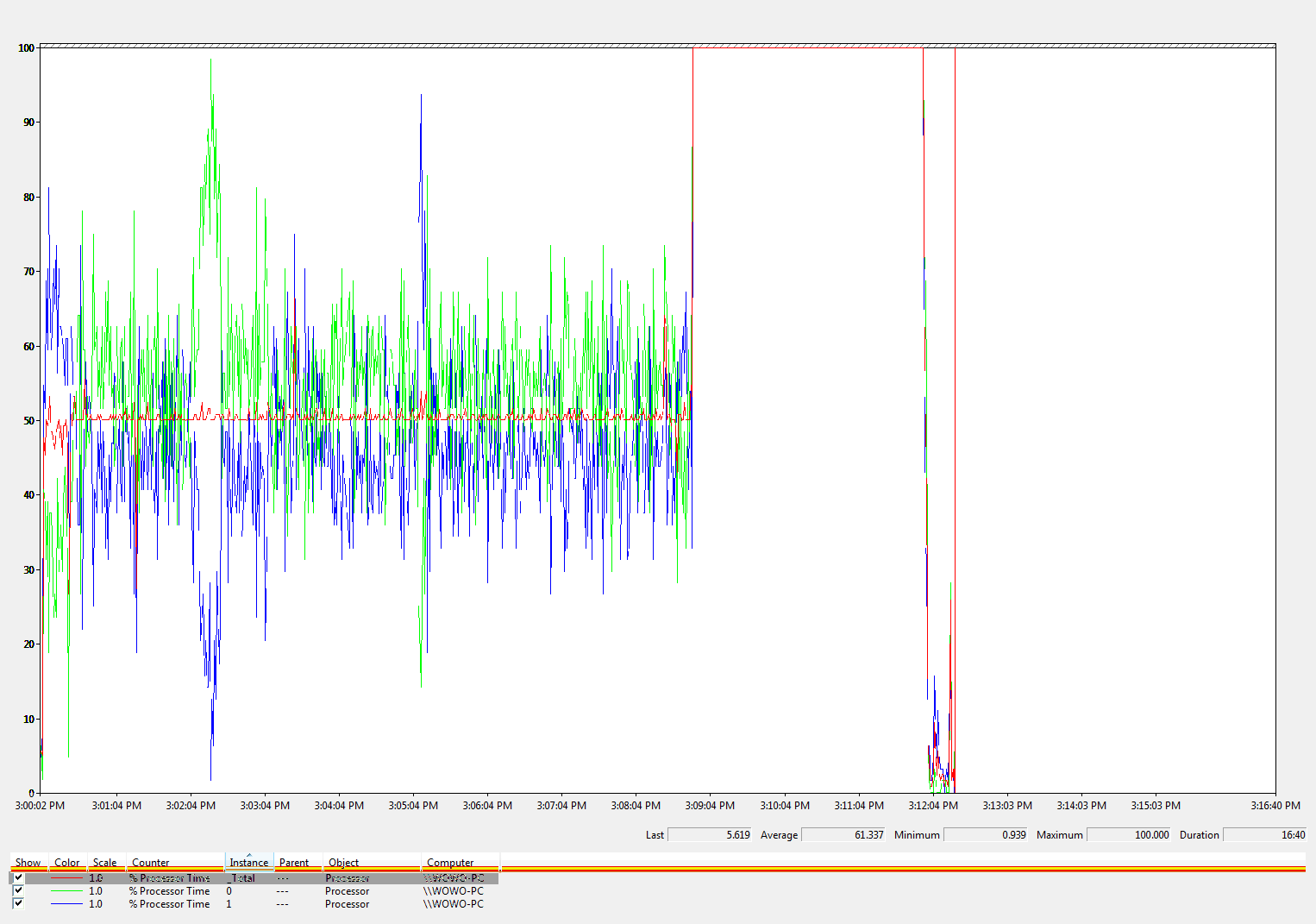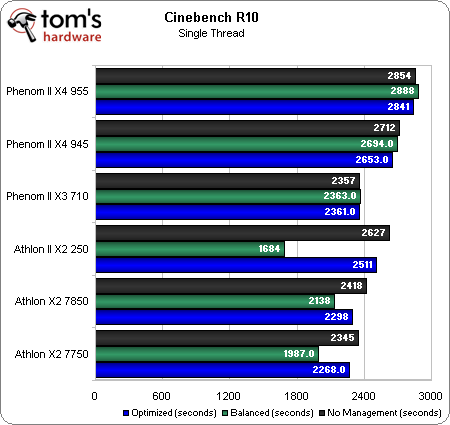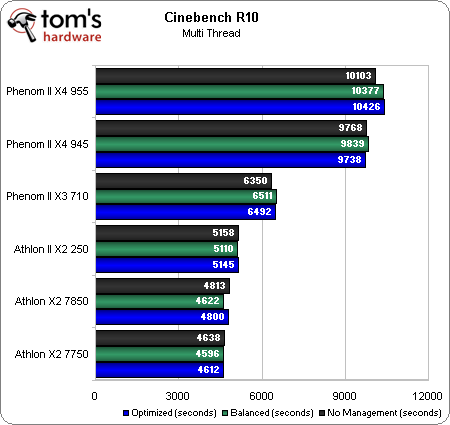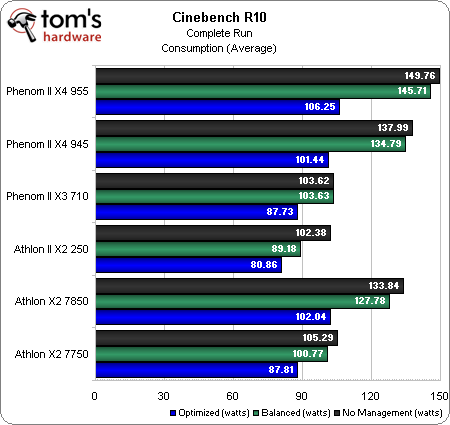Updated: Tuning C'n'Q: Maximize Power And Performance, Part 2
Benchmark Results: Cinebench R10
Unlike the other benchmarks in this article, Cinebench R10 is unique because it stresses the system and processor with different scenarios. There's the OpenGL viewport test, which measures graphics card performance, the single-threaded render test, and the multi-threaded render test, which measures processor performance.
That first part of the graph seems familiar doesn't it? As with SuperPi, performance in Cinebench's OpenGL and single-threaded test suffers when you enable Cool'n'Quiet on the Athlon X2 and Athlon II. In the multi-threaded render test, all cores are utilized--no more thread “jumps.”
Let's look at the test results. Since we’re more interested in processor performance, we're going to focus on the single- and multi-threaded render test results.
We noted before how asynchronous clock changes were adversely affecting performance in single-threaded applications. Cinebench's single-threaded rendering test confirms this. As in SuperPi, “fixing” this behavior returns performance to where it should be--very close to levels without power management. Admittedly, it's still lower, but the difference is small enough not to be noticeable in real usage situations (1–3%); they may even be normal variations between test runs.
The lack of L3 cache and asynchronous clock changes seems to adversely affect performance more on the Athlon II X2 250. It’s more pronounced than on the Athlon X2s. But once that’s not a factor, everything falls into place, and the Athlon II X2 250 takes the lead among dual-core processors due to its higher clock rate. Not surprisingly, the Phenom II X4 955’s 3.4 GHz clock also allows it to take the top position.
The multi-threaded rendering test is basically similar to what we’ve seen before in 3DMark Vantage.
It might be surprising to some, but the results we see here are what we expected when we saw the earlier SuperPi and WinRAR results. Yes, average consumption-wise, the greater number of cores a processor has (and the higher its clock rate), the higher its power consumption. This is true for both single- (SuperPi) and multi-threaded (WinRAR) applications. But both test results also show that if you can get operating voltage low enough, the power consumption differences shrink significantly between a quad-, triple-, and dual-core processor.
Get Tom's Hardware's best news and in-depth reviews, straight to your inbox.
With SuperPI, which is purely single-threaded, total power consumption still favors a processor with the least number of cores. In WinRAR, it’s the reverse. These Cinebench results confirms this, and add a new twist. Even with long periods of single-threaded work (on the OpenGL and single-threaded rendering test), once you run multiple threads (and quite possibly, multiple applications), the quad-core processor actually consume less power. There is catch: you need to reduce the operating voltages.
Current page: Benchmark Results: Cinebench R10
Prev Page Benchmark Results: WinRAR Next Page Benchmark Results: POVRay 3.6-
jedimasterben I'd be interested to see the tests performed on Windows 7 to see what the effect of reducing thread "jumping" would be.Reply -
cnox Dammit...how can this part 2 article be posted before the Building the Balanced PC Part 2?Reply
Cumon.... -
melangex3 Great Stuff. Keep up the good work. This is the type of review that will keep me coming back. How about throwing in the ever popular 720 BE and the new 620 or 630 just for giggles?Reply -
Ryun jedimasterbenI'd be interested to see the tests performed on Windows 7 to see what the effect of reducing thread "jumping" would be.Reply
I was thinking the same thing as well.
Also, were the BIOSs all updated? The asynchronous clocks problem you're experiencing with Athlon II X2 was supposed to be fixed with updated CPU microcode. -
redgarl I must admit that lately AMD is impressive. I got a PII X3 720 BE unleashed at PII X4 20 fully stable with an Asus M4A78T-E latest BIOS. Let simply add that my 2 radeon 4850 OC in Crossfire are running as fast as 2 stock 4870...Reply
If you take into account that the 2 cards only cost 82$ each for a total of 165$ for the two... I can hardly believe that so little money can give so much results. -
JimmiG With my Phenom X4 9650, I found Cool n Quiet to be pretty much worthless without tweaks. There were huge performance drops across the board, especially with tasks that didn't use all four cores, or only loaded cores partially. Videos and games would stutter and skip every couple of frames, compressing files would take longer etc. I basically had a 1.1 GHz CPU that would sometimes run at 2.3 GHz, if it felt like it. Too bad there was no tweak guide available then. I just disabled CnQ which solved all problems but made the system use more power and run hotter.Reply
With my 955BE, I haven't really had a need to tweak CnQ. It might cause a slight performance hit in some rare cases, but generally when I need a 3.2 GHz CPU, that's what it delivers. -
tacoslave Nice, amd owns in the graphics department now with that $1.2 billion im sure amd is heading to pwn BOTH markets.Reply




